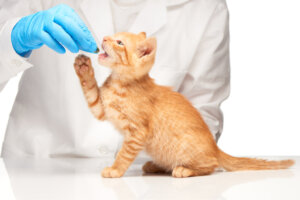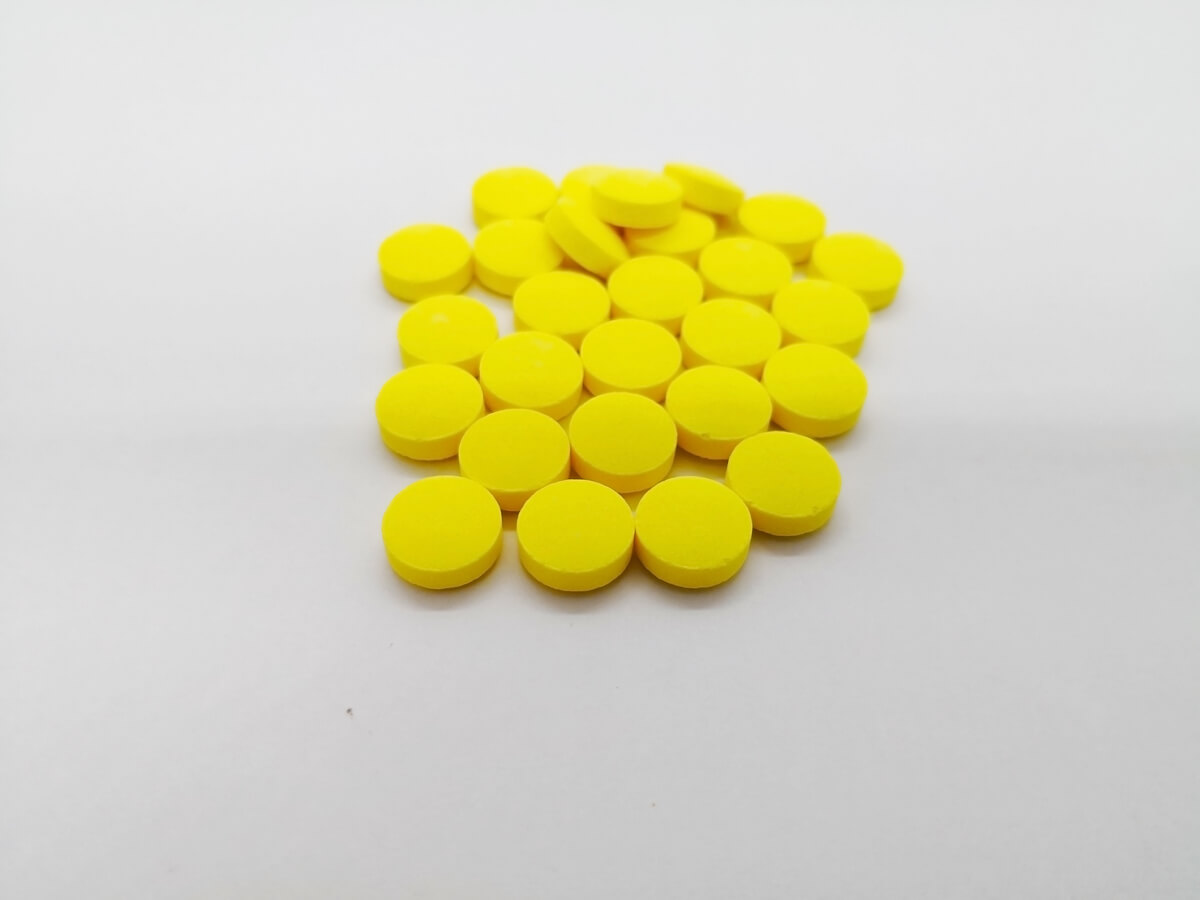When to Administer Metronidazole for Cats?


Written and verified by the vet Juan Pedro Vazquez Espeso
Metronidazole is a curious drug, as it has different benefits that we’ll explain later. This drug is frequently used in the veterinary clinic, as it’s excellent for treating certain ailments associated with the presence of bacteria and parasites in the feline patient.
in this article, we’ll focus on the uses and effects of metronidazole on cats. We’ll also discuss everything you’ll need to know how to administer it effectively. Don’t miss the following lines, but keep in mind that this drug should always be prescribed by an expert in veterinary medicine.
What is metronidazole?
Metronidazole is a drug in the metronidazole family nitroimidazoles. To put it quickly and simply, its mechanism of action is based on inhibiting the synthesis of nucleic acids (DNA) in bacteria, which prevents them from replicating and causes their death. In the world of human medicine, it’s sold in generic form, although it also appears in commercial preparations (such as Flagyl®).
As mentioned in the introduction and due to its pharmacokinetic properties, metronidazole is a drug with antibiotic and antiparasitic activity. This means that it acts against bacteria – specifically against anaerobic bacteria – and is also capable of combating certain groups of parasites sensitive to the active ingredient.
This dual activity makes metronidazole a very useful drug, which is why it’s used quite frequently to treat ailments that we’ll explain later on. In addition, it has anti-inflammatory activity in the gastrointestinal tract, which could be due to a certain degree of immunosuppression in the animal after its administration. That’s why its use should always be monitored by a veterinarian.

Antiparasitic activity of metronidazole
Metronidazole is especially recommended in intestinal infections caused by Giardia spp. This protozoan is a gastrointestinal parasite that commonly affects domestic felines. It’s a pathogen that affects several mammals, including humans, among its possible hosts.
At this point, it’s essential to emphasize that metronidazole is only effective against this specific type of parasite, so it should never be used as the usual antiparasitic treatment against the classic flatworms and roundworms. Nor should it be used under any circumstances to combat diseases of viral or fungal origin, as it doesn’t have any benefits at all.
It’s common for owners to confuse the antiparasitic activity of this drug and believe that they are correctly deworming the cat, when in fact this is not the case.
It should be noted that giardia has zoonotic activity, i.e. it can affect humans. Taking into account that various studies put the total percentage of infected cats at around 12%, the use of this drug is more than justified whenever necessary. Needless to say, extreme handling precautions should be taken if the feline in the household is infected.
Its dosage as an antiparasitic
In many cases of infection by this parasite, cats don’t show any symptoms. However, in some cats it can produce acute small intestinal diarrhea. These diarrhea episodes are usually quite insidious, alternating with periods of normal stools.
Many drugs can target this parasite, but metronidazole stands out for its effectiveness and low toxicity. The effective dose is 50 milligrams per kilogram of body weight, once a day, for 5 to 7 days. It can also be divided into two doses per day, i.e. 25 mg/kg body weight twice a day.
Antibacterial treatment
At this point, it’s worth mentioning a curious fact. Metronidazole is a prodrug, i.e. it must be metabolized in the cat’s organism to become effective. However, its metabolization only occurs at very low oxygen concentrations. For this reason, this drug is exclusively effective against anaerobic microorganisms.
In cats, it’s widely used in the treatment of infections of the gastrointestinal tract caused by anaerobic bacteria, such as microorganisms of the genus Clostridium spp. and Clostridioides. This drug is also effective against pathogenic genera such as Bacteroides, Fusobacterium, Clostridium, and Peptostreptococcus.
This drug, in combination with spiramycin, is also very effective in the treatment of infections related to the oral cavity. This combination therapy is very useful in cases of:
- Periodontal disease: Stomatitis, gingivitis, glossitis or pyorrhea. Combined treatment is very effective for this type of process, which frequently appears in older cats.
- Pharyngeal diseases: Salivary gland infections, tonsillitis and pharyngitis. These respiratory diseases are especially common in cats that roam outside.
Its dosage as an antibacterial
The dosage of metronidazole as part of the treatment for these pathological processes is 12.5 milligrams of the product per kilogram of weight. The treatment usually lasts between 5 and 10 days, always under veterinary indication. Never stop medicating your pet because it looks better physically, as this will encourage the infection to reappear in the future (and it’ll come back stronger).
Contraindications
Although metronidazole is a very useful drug, there are times when its administration is completely inadvisable. We cite the following:
- This medicine shouldn’t be used in any cat that has shown hypersensitivity (allergy) to the active ingredient or to any of its components.
- It isn’t recommended in pregnant and lactating cats.
- It shouldn’t be prescribed for very weak cats.
- It should be used with caution in kittens, cats with liver problems, and those taking anticoagulants.
It should also be noted that metronidazole may report concomitant effects if applied with drugs such as phenobarbital, warfarin, or cyclosporine, among many others. Consult your veterinarian if your cat is already taking medication.
Side effects
Metronidazole crosses the blood-brain barrier in cats, i.e. it reaches the nervous system. Therefore, it reports certain side effects that should be known before starting treatment with the feline. Here are the most common ones:
- Generalized depression and apathy
- Difficulty and wobbling when making movements
- Unusual eye movements
- A tilt of the head
- Tremors and convulsions
- Body rigidity
- Excessive salivation, nausea, vomiting, and loss of appetite
On the other hand, an overdose of metronidazole can cause quite serious effects in your feline. These include bradycardia, ataxia (a severe lack of coordination) and very severe gastrointestinal signs. Depending on the severity of the case, neurotoxicosis could occur in the animal, which would cause a permanent decrease in neuronal function.
These symptoms usually begin between 7 and 12 days after the application of the treatment, or when exceeding 58 milligrams per kilo. Whatever happens, you should stop administering the drug as soon as the above symptoms appear.

An excellent drug with a few reservations
As you’ve been able to read, metronidazole is a very effective and useful drug for the treatment of certain processes. One of the reasons for this great efficacy is its specificity, although this characteristic also has its negative counterpart.
The fact that a drug is very effective against specific types of microorganisms means that it should be used with caution and always as a treatment against the microorganism in question.
Unfortunately, the indiscriminate use of this type of drug only leads to the development of resistance. For this reason, before using metronidazole on cats, a visit to the veterinarian is always recommended. After examining the animal, they will decide whether to prescribe it or not. Never self-medicate your pet.
Metronidazole is a curious drug, as it has different benefits that we’ll explain later. This drug is frequently used in the veterinary clinic, as it’s excellent for treating certain ailments associated with the presence of bacteria and parasites in the feline patient.
in this article, we’ll focus on the uses and effects of metronidazole on cats. We’ll also discuss everything you’ll need to know how to administer it effectively. Don’t miss the following lines, but keep in mind that this drug should always be prescribed by an expert in veterinary medicine.
What is metronidazole?
Metronidazole is a drug in the metronidazole family nitroimidazoles. To put it quickly and simply, its mechanism of action is based on inhibiting the synthesis of nucleic acids (DNA) in bacteria, which prevents them from replicating and causes their death. In the world of human medicine, it’s sold in generic form, although it also appears in commercial preparations (such as Flagyl®).
As mentioned in the introduction and due to its pharmacokinetic properties, metronidazole is a drug with antibiotic and antiparasitic activity. This means that it acts against bacteria – specifically against anaerobic bacteria – and is also capable of combating certain groups of parasites sensitive to the active ingredient.
This dual activity makes metronidazole a very useful drug, which is why it’s used quite frequently to treat ailments that we’ll explain later on. In addition, it has anti-inflammatory activity in the gastrointestinal tract, which could be due to a certain degree of immunosuppression in the animal after its administration. That’s why its use should always be monitored by a veterinarian.

Antiparasitic activity of metronidazole
Metronidazole is especially recommended in intestinal infections caused by Giardia spp. This protozoan is a gastrointestinal parasite that commonly affects domestic felines. It’s a pathogen that affects several mammals, including humans, among its possible hosts.
At this point, it’s essential to emphasize that metronidazole is only effective against this specific type of parasite, so it should never be used as the usual antiparasitic treatment against the classic flatworms and roundworms. Nor should it be used under any circumstances to combat diseases of viral or fungal origin, as it doesn’t have any benefits at all.
It’s common for owners to confuse the antiparasitic activity of this drug and believe that they are correctly deworming the cat, when in fact this is not the case.
It should be noted that giardia has zoonotic activity, i.e. it can affect humans. Taking into account that various studies put the total percentage of infected cats at around 12%, the use of this drug is more than justified whenever necessary. Needless to say, extreme handling precautions should be taken if the feline in the household is infected.
Its dosage as an antiparasitic
In many cases of infection by this parasite, cats don’t show any symptoms. However, in some cats it can produce acute small intestinal diarrhea. These diarrhea episodes are usually quite insidious, alternating with periods of normal stools.
Many drugs can target this parasite, but metronidazole stands out for its effectiveness and low toxicity. The effective dose is 50 milligrams per kilogram of body weight, once a day, for 5 to 7 days. It can also be divided into two doses per day, i.e. 25 mg/kg body weight twice a day.
Antibacterial treatment
At this point, it’s worth mentioning a curious fact. Metronidazole is a prodrug, i.e. it must be metabolized in the cat’s organism to become effective. However, its metabolization only occurs at very low oxygen concentrations. For this reason, this drug is exclusively effective against anaerobic microorganisms.
In cats, it’s widely used in the treatment of infections of the gastrointestinal tract caused by anaerobic bacteria, such as microorganisms of the genus Clostridium spp. and Clostridioides. This drug is also effective against pathogenic genera such as Bacteroides, Fusobacterium, Clostridium, and Peptostreptococcus.
This drug, in combination with spiramycin, is also very effective in the treatment of infections related to the oral cavity. This combination therapy is very useful in cases of:
- Periodontal disease: Stomatitis, gingivitis, glossitis or pyorrhea. Combined treatment is very effective for this type of process, which frequently appears in older cats.
- Pharyngeal diseases: Salivary gland infections, tonsillitis and pharyngitis. These respiratory diseases are especially common in cats that roam outside.
Its dosage as an antibacterial
The dosage of metronidazole as part of the treatment for these pathological processes is 12.5 milligrams of the product per kilogram of weight. The treatment usually lasts between 5 and 10 days, always under veterinary indication. Never stop medicating your pet because it looks better physically, as this will encourage the infection to reappear in the future (and it’ll come back stronger).
Contraindications
Although metronidazole is a very useful drug, there are times when its administration is completely inadvisable. We cite the following:
- This medicine shouldn’t be used in any cat that has shown hypersensitivity (allergy) to the active ingredient or to any of its components.
- It isn’t recommended in pregnant and lactating cats.
- It shouldn’t be prescribed for very weak cats.
- It should be used with caution in kittens, cats with liver problems, and those taking anticoagulants.
It should also be noted that metronidazole may report concomitant effects if applied with drugs such as phenobarbital, warfarin, or cyclosporine, among many others. Consult your veterinarian if your cat is already taking medication.
Side effects
Metronidazole crosses the blood-brain barrier in cats, i.e. it reaches the nervous system. Therefore, it reports certain side effects that should be known before starting treatment with the feline. Here are the most common ones:
- Generalized depression and apathy
- Difficulty and wobbling when making movements
- Unusual eye movements
- A tilt of the head
- Tremors and convulsions
- Body rigidity
- Excessive salivation, nausea, vomiting, and loss of appetite
On the other hand, an overdose of metronidazole can cause quite serious effects in your feline. These include bradycardia, ataxia (a severe lack of coordination) and very severe gastrointestinal signs. Depending on the severity of the case, neurotoxicosis could occur in the animal, which would cause a permanent decrease in neuronal function.
These symptoms usually begin between 7 and 12 days after the application of the treatment, or when exceeding 58 milligrams per kilo. Whatever happens, you should stop administering the drug as soon as the above symptoms appear.

An excellent drug with a few reservations
As you’ve been able to read, metronidazole is a very effective and useful drug for the treatment of certain processes. One of the reasons for this great efficacy is its specificity, although this characteristic also has its negative counterpart.
The fact that a drug is very effective against specific types of microorganisms means that it should be used with caution and always as a treatment against the microorganism in question.
Unfortunately, the indiscriminate use of this type of drug only leads to the development of resistance. For this reason, before using metronidazole on cats, a visit to the veterinarian is always recommended. After examining the animal, they will decide whether to prescribe it or not. Never self-medicate your pet.
All cited sources were thoroughly reviewed by our team to ensure their quality, reliability, currency, and validity. The bibliography of this article was considered reliable and of academic or scientific accuracy.
- Rodríguez-Pardo, D., Mirelis, B., & Navarro, F. (2013). Infecciones producidas por Clostridium difficile. Enfermedades Infecciosas y Microbiologia Clinica, 31(4), 254-263.
- Bouzid, M., Halai, K., Jeffreys, D., & Hunter, P. R. (2015). The prevalence of Giardia infection in dogs and cats, a systematic review and meta-analysis of prevalence studies from stool samples. Veterinary Parasitology, 207(3-4), 181-202.
- Noval Ramírez, Y. (2017). Toxicología en gatos domésticos (Felis Catus). (Trabajo de Grado, Universidad de Ciencias Aplicadas y Ambientales).
This text is provided for informational purposes only and does not replace consultation with a professional. If in doubt, consult your specialist.








